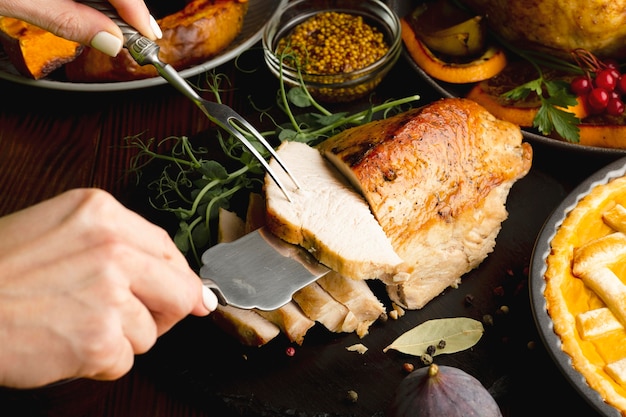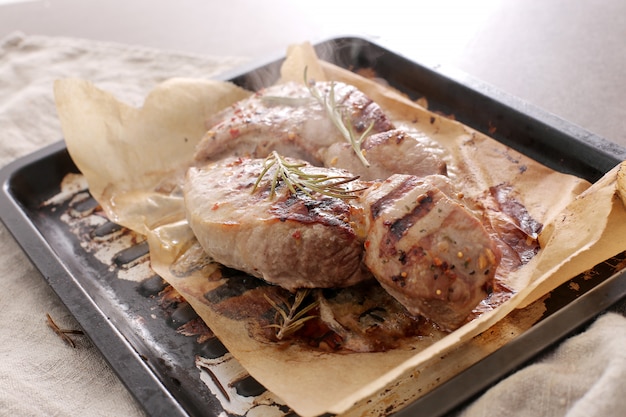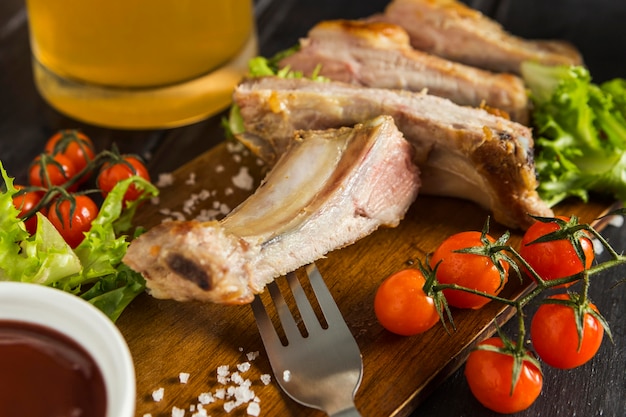Ah, the pork loin. It's a staple in many kitchens, offering a satisfyingly tender and versatile canvas for culinary creativity. But let's be honest, sometimes you get that dry, disappointing piece of meat instead of the succulent, juicy dream you envisioned. Fear not, my fellow food enthusiast! This guide is your ticket to mastering the art of cooking a pork loin that'll have everyone singing your praises.
(Part 1) Choosing the Right Pork Loin: It All Starts with the Right Cut

The journey begins before the first flame is even lit. You can't just grab any old pork loin and expect a masterpiece. Picking the right cut is crucial, and trust me, it's not as complicated as it seems!
Navigating the Supermarket: Understanding the Cuts
The meat section can feel like a jungle sometimes. But let's simplify it. There are a few key pork loin cuts you'll encounter, and each has its own personality and ideal applications:
- Center-Cut Pork Loin: This is the classic. Think of it as the "all-arounder" of the pork loin world. It's usually about 1.5 to 2 inches thick, perfect for roasting, grilling, or pan-frying. The downside? It can be a tad lean, so you'll need to be extra careful with cooking methods to ensure it doesn't dry out.
- Boneless pork loin roast: This is basically the center-cut, just without the bone and often rolled into a more compact shape. It's ideal for those who prefer boneless roasts and especially great for slow-cooking, where it gets wonderfully tender and flavorful.
- pork tenderloin: This is the "smaller sibling" of the loin family. It's a delicate, cylindrical cut, often found in pairs, known for its tender texture. It's perfect for pan-frying or grilling and works well with quick cooking methods.
The Pork Selection Checklist: Picking the Perfect Piece
So you've chosen your cut. Now, let's find the ideal pork to transform into a culinary masterpiece. Here's what to look for:
- Fresher than Fresh: Look for pork that's bright, with a firm texture. Avoid anything with discoloration or that smells off. Freshness is key!
- Fat Is Your Friend: Don't shy away from a thin layer of marbling. It's not just about appearance; fat adds flavor and keeps the pork moist during cooking. It's the difference between dry, boring meat and juicy, flavorful goodness.
- Size Matters: Consider the size of your pork loin relative to the number of people you're feeding. You don't want to be left with leftovers for weeks, nor do you want to end up with a tiny portion per person. Pick a size that's just right for your meal.
(Part 2) Preparing Your Pork Loin: Setting the Stage for Success

You've chosen the perfect cut, now it's time to prep it for cooking. This is where you can truly add flavor and make sure your pork loin turns out amazing.
Pat, Salt, and Season: A Symphony of Flavors
First things first, grab some paper towels and pat your pork loin dry. This ensures a crispy outer layer and prevents excess moisture from steaming during cooking. Then, generously salt the entire pork loin. I swear by kosher salt – its larger grains dissolve more slowly, allowing for a more even seasoning.
Now, onto the fun part: seasoning! This is your chance to get creative and make your pork loin uniquely yours. I love a simple blend of black pepper, garlic powder, and onion powder, but the possibilities are endless! Experiment with your favorite herbs and spices – remember, a little goes a long way.
The Art of Marinades: Infusing Flavor and Moisture
Want to take your pork loin to the next level? A marinade is your secret weapon. It infuses flavor and helps keep the pork moist. My personal favorite is a simple mix of soy sauce, honey, and garlic – it's a symphony of umami and sweetness. But feel free to explore. Ginger, lemon juice, even a dash of chili flakes for a kick – the possibilities are endless!
Let your pork loin marinate for at least 30 minutes, or better yet, a few hours for maximum flavor penetration. It's a waiting game worth the reward.
Relaxation Time: Letting the Pork Loin Chill
Before you start cooking, give your seasoned or marinated pork loin a 30-minute rest at room temperature. This allows the meat to come to a more even temperature, resulting in more consistent cooking and a more tender final product.
(Part 3) The Ultimate Guide to Roasting a Juicy Pork Loin: A Classic for a Reason

For that melt-in-your-mouth experience, roasting reigns supreme. It's the classic method for a reason, and with a few insider tips, you'll be a roasting master in no time.
The Heat is On: Finding the Perfect Oven Temperature
Aim for an oven temperature of 350°F (175°C). This is the sweet spot for a perfectly cooked pork loin. It ensures even cooking and prevents the meat from drying out. You'll achieve that glorious golden-brown crust and juicy interior.
The Roast Timeline: How Long is Too Long?
The roasting time depends on the size of your pork loin. As a general rule, it takes about 20 to 30 minutes per pound. But don't rely solely on time. The best way to know when your pork loin is cooked through is to use a meat thermometer. It should reach an internal temperature of 145°F (63°C) for a safe and juicy result.
The Secret Weapon: The Art of Basting
Basting is a game-changer. It adds moisture and flavor, taking your pork loin to another level. My go-to basting mixture is a heavenly blend of melted butter, chicken broth, and honey. You'll want to baste your pork loin every 30 minutes or so, ensuring every nook and cranny gets a good dose of that delicious elixir.
The Rest is Key: Allowing the Juices to Redistribute
After roasting, don't rush to slice into your pork loin. Let it rest for at least 10 to 15 minutes. This allows the juices to redistribute throughout the meat, resulting in a wonderfully tender and flavorful pork loin. Trust me, the wait is worth it.
(Part 4) Mastering the Art of Grilling a Pork Loin: Smoky Flavor and Grill Marks
If you're craving that smoky, grilled flavor, grilling a pork loin is your ticket to a delicious outdoor meal. But grilling is a dance. Follow these steps for a perfectly grilled pork loin.
Preheating the Grill: A Hot Start for a Great Finish
Preheating your grill to medium heat (around 350°F/175°C) is essential. A properly heated grill ensures even cooking and those irresistible grill marks. It's like giving your pork loin a warm welcome.
Direct vs. Indirect Heat: Understanding the Grill's Language
For grilling a pork loin, indirect heat is your best friend. Place the pork loin on a part of the grill away from the direct heat source. This prevents burning the outside and ensures the pork loin cooks evenly throughout. You can do this by placing it over a drip pan or using a two-zone grilling method.
Grilling Time: It's Not a Race, It's a Process
Grilling time varies depending on the size and thickness of your pork loin. A general guideline is about 25 to 35 minutes for a 1-inch thick pork loin. As with roasting, use a meat thermometer to ensure it reaches 145°F (63°C). Don't rely solely on time!
The Flip Factor: One Turn is All It Takes
Only flip your pork loin once during grilling. This helps create those gorgeous grill marks and ensures even cooking. Flipping it too often can dry out the meat. It's all about patience and precision.
Resting is the Key: Letting the Juices Settle
After grilling, let the pork loin rest for 10 to 15 minutes before slicing. This allows the juices to redistribute, resulting in a juicy and flavorful pork loin. It's a crucial step for tender, delicious results.
(Part 5) Pan-Frying a Pork Loin: Quick, Easy, and Absolutely Delicious
Pan-frying is all about simplicity and speed, making it perfect for weeknight meals. It's a quick way to achieve a flavorful pork loin that's perfect for a variety of dishes.
The Right Pan: A Foundation for Success
You'll need a heavy-bottomed skillet or cast-iron pan that distributes heat evenly. This prevents sticking and ensures even cooking. Choose a pan that can handle the heat and hold its own.
Heating the Oil: The Perfect Temperature
Heat a thin layer of oil in your pan over medium-high heat. You want the oil to be hot enough to sear the pork loin without burning it. Think of it as creating a crisp, flavorful crust.
Searing: Locking In Flavor and Creating a Crispy Crust
Sear the pork loin for 2 to 3 minutes per side. This creates that gorgeous golden-brown crust and seals in the juices, resulting in a flavorful, tender pork loin. It's a crucial step for pan-frying success.
Lowering the Heat: Finishing the Cook
Once the pork loin is seared, reduce the heat to medium-low and continue cooking for about 10 to 15 minutes, or until the internal temperature reaches 145°F (63°C). You may need to cover the pan with a lid for a few minutes to help the pork loin cook through.
Rest, Relax, and Enjoy: Letting the Juices Redistribute
After pan-frying, let the pork loin rest for 5 to 10 minutes before slicing. This allows the juices to redistribute, resulting in a tender and juicy pork loin. It's a simple step that makes a big difference.
(Part 6) Slow-Cooking a Pork Loin: Tenderness and Flavor, All in One
Slow-cooking is like a culinary hug for your pork loin. It's a method that delivers incredibly tender and flavorful results. It's perfect for those busy days when you need a meal that practically cooks itself.
slow cooker Selection: Choosing Your Partner in Cooking
Pick a slow cooker that's big enough to accommodate your pork loin. Also, consider features like temperature adjustment and a timer, which can be helpful for fine-tuning your cooking process.
Seasoning and Preparing: Laying the Flavor Foundation
Season your pork loin with your favorite herbs and spices. I'm a fan of a blend of garlic powder, onion powder, paprika, and black pepper. But feel free to get creative and use a pre-made seasoning blend or a dry rub for extra flavor. The possibilities are endless.
The Magic of Liquid: Keeping the Pork Loin Moist
Add about 1 cup of liquid to the bottom of your slow cooker. Chicken broth, apple cider, or even a combination work well. The liquid keeps the pork loin moist and tender during the long cooking process.
Slow-cooking time: Patience is a Virtue
Slow-cooking time depends on the size of your pork loin and the temperature setting of your slow cooker. As a general rule, it takes 6 to 8 hours on low or 3 to 4 hours on high. You'll know it's ready when it's fork-tender and easily pulls apart.
Rest and Shred: The Final Touches
After slow-cooking, let the pork loin rest for at least 10 minutes before shredding it with two forks. This allows the juices to redistribute and makes it easier to shred, resulting in a tender, flavorful, and perfectly shreddable pork loin.
(Part 7) Pork Loin Leftovers: A Culinary Treasure Trove
Don't let those delicious pork loin leftovers languish in the fridge! They're a blank canvas for creating a symphony of tasty dishes.
Sandwiches and Wraps: A quick and easy meal
leftover pork loin is perfect for sandwiches and wraps. Slice it thinly and add it to your favorite bread or wrap, along with your favorite toppings. It's a quick and satisfying meal.
Salads and Bowls: Adding Protein and Flavor
Dice or shred leftover pork loin and add it to your salads or bowls for a boost of protein and flavor. It pairs wonderfully with greens, vegetables, and a light dressing. It's a healthy and delicious way to use up those leftovers.
Soups and Stews: Enhancing Flavor and Texture
Leftover pork loin adds depth of flavor and texture to soups and stews. It's a great way to elevate your favorite recipes and create a hearty, satisfying meal.
pasta dishes: Adding a Touch of Distinction
Slice leftover pork loin thinly and add it to your pasta sauce or use it as a topping for a creamy pasta dish. It's a simple way to add a touch of protein and flavor to your pasta creations.
(Part 8) Serving Suggestions: Elevating Your Pork Loin Presentation
Now that you've mastered the art of cooking a juicy pork loin, it's time to present it in a way that's as delicious as it tastes.
side dishes: The Perfect Complement
Choose side dishes that complement the flavor of your pork loin. Roasted vegetables, mashed potatoes, or a simple green salad are all excellent choices. Consider the flavors and textures you want to create for a well-rounded meal.
Sauces and Gravies: A Symphony of Flavor
A flavorful sauce or gravy can really take your pork loin to the next level. Make a simple pan sauce using the drippings from the pan, or try a classic gravy recipe. For a touch of sweetness, try a honey-mustard glaze or a tangy cranberry sauce.
Garnishes: A Touch of Elegance
A few simple garnishes can make your pork loin look even more appealing. Fresh herbs, citrus wedges, or a drizzle of balsamic glaze can add a touch of elegance and visual appeal.
Presentation: Making it Special
Take your time when plating your pork loin. Arrange it beautifully on a platter and surround it with your chosen side dishes. Use a sprig of fresh rosemary or a few slices of lemon for a touch of elegance. It's a simple step that can make a big difference.
FAQs: Your Pork Loin Questions Answered
Here are some frequently asked questions about cooking a juicy pork loin, to help you on your culinary journey.
| Question | Answer |
|---|---|
| How do I know if my pork loin is cooked properly? | The golden rule: use a meat thermometer! It should reach 145°F (63°C) for a safe and juicy pork loin. |
| What happens if my pork loin is overcooked? | overcooked pork loin is dry and tough, a culinary tragedy. To prevent this, cook it to the correct internal temperature and rest it properly after cooking. Patience is key! |
| Can I freeze leftover pork loin? | Absolutely! It will keep well in the freezer for up to 3 months. Wrap it tightly in plastic wrap or aluminum foil and place it in a freezer-safe bag. |
| What are some good tips for making a pan sauce from the drippings? | Deglaze the pan with a little wine or broth, scraping up any browned bits from the bottom. Add a tablespoon of butter and simmer until the sauce thickens. Season to taste with salt, pepper, and any other desired herbs or spices. It's a delicious way to use those flavorful drippings. |
| How can I tell if my pork loin is spoiled? | Spoiled pork loin will have a sour or ammonia-like smell, a slimy texture, and a grayish discoloration. If you notice any of these signs, it's best to discard the pork loin. |
With this ultimate guide in your culinary arsenal, you're all set to conquer the art of cooking a juicy pork loin. Go forth, experiment with flavors, and enjoy the delicious results! Happy cooking!
Everyone is watching

Perfect Rice Every Time: The Ultimate Guide to Cooking Rice
Cooking TipsAs a self-proclaimed foodie, I've always been a bit obsessed with rice. It's the foundation of countless cuisi...

Prime Rib Roast Cooking Time Chart: Per Pound Guide
Cooking TipsPrime rib roast. Just the name conjures images of lavish dinners, crackling fires, and hearty laughter. It’s ...

How Long to Bake Potatoes in the Oven (Perfect Every Time)
Cooking TipsBaked potatoes are a staple in my kitchen. They're incredibly versatile, delicious, and surprisingly easy to m...

The Ultimate Guide to Cooking Asparagus: Tips, Techniques, and Recipes
Cooking TipsAsparagus. The mere mention of this spring delicacy conjures up images of vibrant green spears, crisp and burs...

Ultimate Guide to Cooking the Perfect Thanksgiving Turkey
Cooking TipsThanksgiving. Just the word conjures up images of overflowing tables laden with delicious food, the scent of r...
